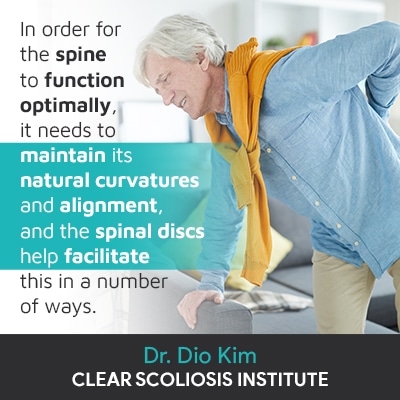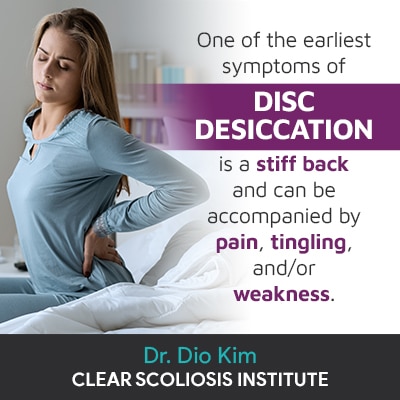
In order for the spine to perform optimally, it has to maintain its natural curvatures and alignment, and this is facilitated by the spine’s intervertebral discs. The intervertebral discs generally show the first signs of spinal degeneration, including disc desiccation. Keep reading to learn more about disc desiccation causes, symptoms, and treatment.
The spinal discs sit between adjacent vertebrae and give the spine structure, flexibility, and act as its shock absorbers. Disc desiccation is a type of disc degeneration that occurs when a disc loses fluid, becomes dehydrated, and changes shape as a result.
Let’s start our exploration of disc desiccation by first discussing the anatomy of the spinal discs and their role in preserving overall spinal health and function.
The spine is made up of bones called vertebrae that are stacked on top of one another in a straight, neutral, and natural alignment.
A healthy spine will appear straight when viewed from the front and back and will take on a soft ‘S’ shape when viewed from the sides.

The intervertebral discs sit between adjacent vertebrae and consist of two main components: a tough durable outer layer called the annulus fibrosus and a soft gel-like interior called the nucleus pulposus.
The annulus is composed of concentric sheets of lamellae (collagen fibers) that connect to the vertebral end plates, giving the spine structure.
The annulus encases the inner nucleus which also contains a network of fibers suspended in mucoprotein gel.
While both the annulus and nucleus are made up of water, collagen, and proteoglycans (PGs), the inner nucleus contains more fluid, consisting of water and PGs; PGs are crucial because they attract and hold water.
So now let’s talk about disc degeneration and, specifically, disc desiccation.
Disc desiccation refers to the loss of hydration experienced by one or more of the intervertebral discs and is a common aspect of degenerative disc disease.
When we’re born, the discs are made up of 80-percent water, and in order for the discs to function optimally, they need to stay as hydrated as possible.
As the nucleus bears the brunt of the body’s axial load, it relies on its contents, including its fluid level, to stay strong and pliable.
The discs are generally the first spinal structure to experience degenerative changes, and as this occurs over time, the spine’s ability to maintain its natural curvatures and alignment can be disrupted.
The spine’s natural curvatures make it stronger, more flexible, and better able to absorb/distribute mechanical stress that’s incurred during movement; when the spine loses one or more of its healthy curves, they are replaced by bad curves, and this disrupts the spine’s biomechanics.
So now that we have defined disc desiccation and the roles the intervertebral discs play in preserving spinal function and health, let’s address the causes of disc desiccation.
The spine, just like the rest of the body, can experience natural age-related degenerative changes.
In many cases of disc desiccation, it’s a feature of degenerative disc disease, and this is commonly caused by age-related spinal deterioration and the cumulative effect of certain lifestyle choices: obesity, inactivity, chronic poor posture, and repeatedly lifting heavy objects incorrectly so the spine is exposed to uneven wear and strain.
Carrying excess weight and/or leading a sedentary lifestyle can affect the longevity of the spinal discs as obesity means the spine, and its parts, have excess weight to carry and are more likely to become strained; conversely, losing weight suddenly can also affect the health of the intervertebral discs as it can cause a significant amount of fluid loss in the body, including the spinal discs.
Not being active affects the discs negatively because as they don’t have their own vascular supply, this means there is no direct path in and out of the discs for transporting blood (nutrients and oxygen) and eliminating waste; instead, the discs absorb what they need from their surroundings through osmosis.
The discs stay hydrated by movement and increasing the circulation of their surroundings, so if regular activity is lacking, over time, this can lead to a decrease in the discs’ inner fluid levels.
Even not drinking enough water can compromise the discs’ fluid levels as, over time, dehydration lowers the body’s general fluid level, and by extension, the discs’ hydration as well.
While less common, trauma can also cause disc desiccation as an accident, fall, or sports injury can cause significant spinal damage.
So what are the symptoms of disc desiccation?
Disc desiccation, like most spinal issues/conditions, can range in severity.
Even those facing disc desiccation are not guaranteed to experience noticeable symptoms and be aware of the issue.
So while there is a normal range of disc desiccation related to aging, once the intervertebral discs lose hydration beyond this normal level, noticeable symptoms can develop.
Symptoms of disc desiccation will vary based on a number of important factors: patient age and health, causation, severity, location of the affected disc(s), and the degree of nerve involvement.

If a desiccated disc has lost height due to fluid loss, the shift in position can affect the vertebral bodies attached to it, and either the disc itself, and/or the affected vertebrae, can press on nearby nerves, irritating them and causing radicular pain/numbness that can radiate down the legs and into the knees and feet.
So now that we have defined disc desiccation and discussed its causes and symptoms, how does one treat it?
For patients experiencing mild symptoms of disc desiccation, it’s likely that some lifestyle changes such as maintaining a healthy weight, staying active, and practicing good posture will improve overall spinal health, gradually improving the function of the intervertebral discs; guidance on the ergonomics of proper lifting can also help protect the spine from strain and injury.
For patients experiencing more-severe symptoms, a conservative chiropractic-centered approach combines different forms of treatment, including chiropractic care and rehabilitation, to work towards reducing joint stress, facilitating a structural change, increasing circulation in the affected disc’s surroundings, and increasing core strength.
Part of the CLEAR treatment protocol is to fully customize treatment plans so individual condition characteristics such as patient age, causation, affected-disc location, and condition severity are addressed proactively.
Treatment involves increasing core strength as making the muscles surrounding the spine stronger takes pressure off the spine and its discs by providing optimal spinal support/stabilization.
It should also be explained that just as disc desiccation occurs slowly over time, efforts needed to reverse its effects are neither quick, nor easy, and when it comes to achieving an actual reversal of disc desiccation, this is generally only possible during the early stages of disc degeneration.
As mentioned, mild disc desiccation and degeneration is not commonly associated with noticeable symptoms, meaning that in most cases, it’s not caught early enough to achieve a full reversal of its effects.
That being said, while it can take time and effort, positive lifestyle changes combined with proactive treatment can work towards improving intervertebral disc function and health.
While there are no treatment guarantees, through condition-specific chiropractic care and increasing core strength, reducing joint stress and strengthening the muscles surrounding the spine can help take pressure off the discs and increase fluid levels, thereby slowing the effects of spinal degeneration/desiccation.
In addition to the CLEAR-treatment protocols, it is my opinion that the chiropractic Cox® Technic can effectively help to reduce pressure from the discs. The Cox® Technic is a form of flexion-distraction decompression adjustment and manipulation that can be done on the Cox chiropractic table. It is a very gentle, well-researched, and evidence-based technique. It can also address conditions such as a disc herniation, disc rupture, stenosis, facet syndrome, and/or spondylolisthesis.
While a certain degree of spinal degeneration is to be expected with age, there are preventative steps that can be taken to minimize these effects.
The very design of the spine is based on movement, so maintaining a healthy weight, activity level, and knowing how to properly lift heavy objects can help protect the spine, and its discs, from excessive strain and fluid loss.
When the discs experience a loss of hydration, this is known as disc desiccation and can affect the spine’s overall health and function.
If left untreated, a desiccated disc can disrupt the biomechanics of the entire spine by losing height, and this can cause a shift in the positioning of adjacent vertebral bodies attached to the affected disc, causing the spine to become misaligned.
If disc desiccation is producing noticeable symptoms, the level of spinal deterioration is likely quite advanced; in these cases, I would integrate different treatment disciplines, such as chiropractic and rehabilitation, that work towards reducing joint stress, achieving a structural change, increasing circulation around the affected disc(s), and increasing core strength so pressure is taken off the spine and its discs.
As a CLEAR-certified scoliosis chiropractor, I believe in working closely with patients to protect the spine’s overall health and function by applying proactive treatment that addresses the specifics of important patient/condition characteristics.

CLEAR provides a unique and innovative way of understanding scoliosis. Sign up to receive facts and information you won’t find anywhere else.

Your article about disc dedication was very helpful to me. I was told by the NPN, in the pain mgmt. officethat I go to, that chiropractic care Petoskey wouldn't help. Only Steroid injections would help. I thought that was very odd. But we are trained not to question Dr's diagnosis of one is given. So thank you. I will try to research some chiropractic offices near my home in Florissant MO.
Paige French
I'm glad the article was helpful, Paige. The only CLEAR clinic in Missouri is in the KC area, but I recommend speaking with him even though he's not very close to you. He'll be able to answer any questions you have, and may know of someone in your area he can recommend.
Dr. Nick Weddle, DC
Certification Level
Intensive & Standard Care
Year Certified: 2015
314 Main St.
Belton, MO 64012
816-425-5578
[email protected]
Great explanation! I've been dealing with back pain for a while, and after reading this, I now understand the possible role of disc desiccation. Looking forward to exploring the treatment options you mentioned. Thanks for the helpful information!